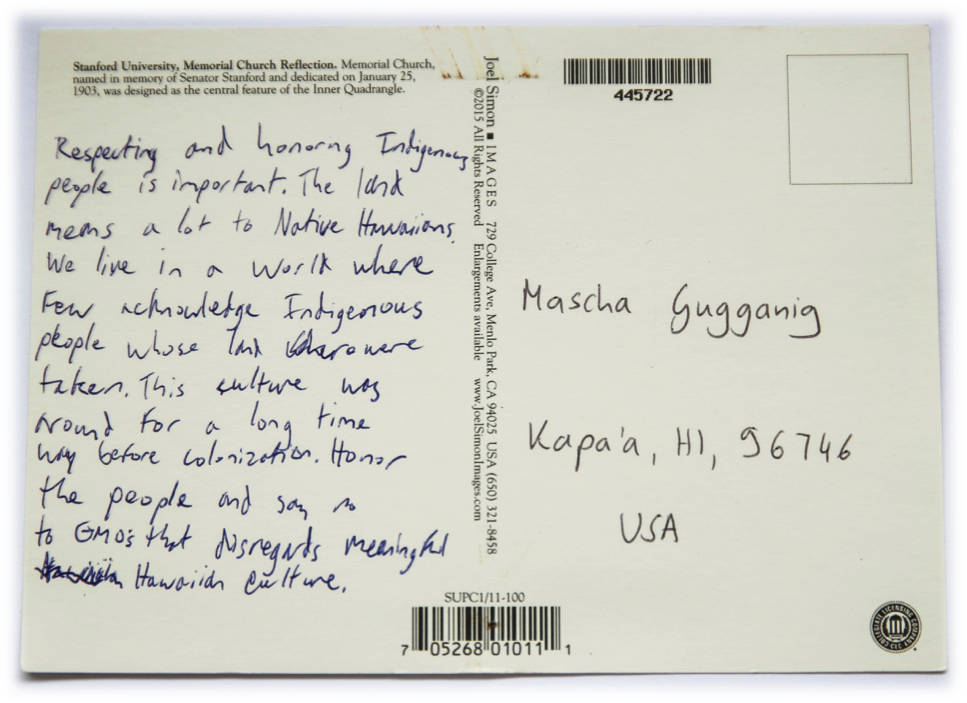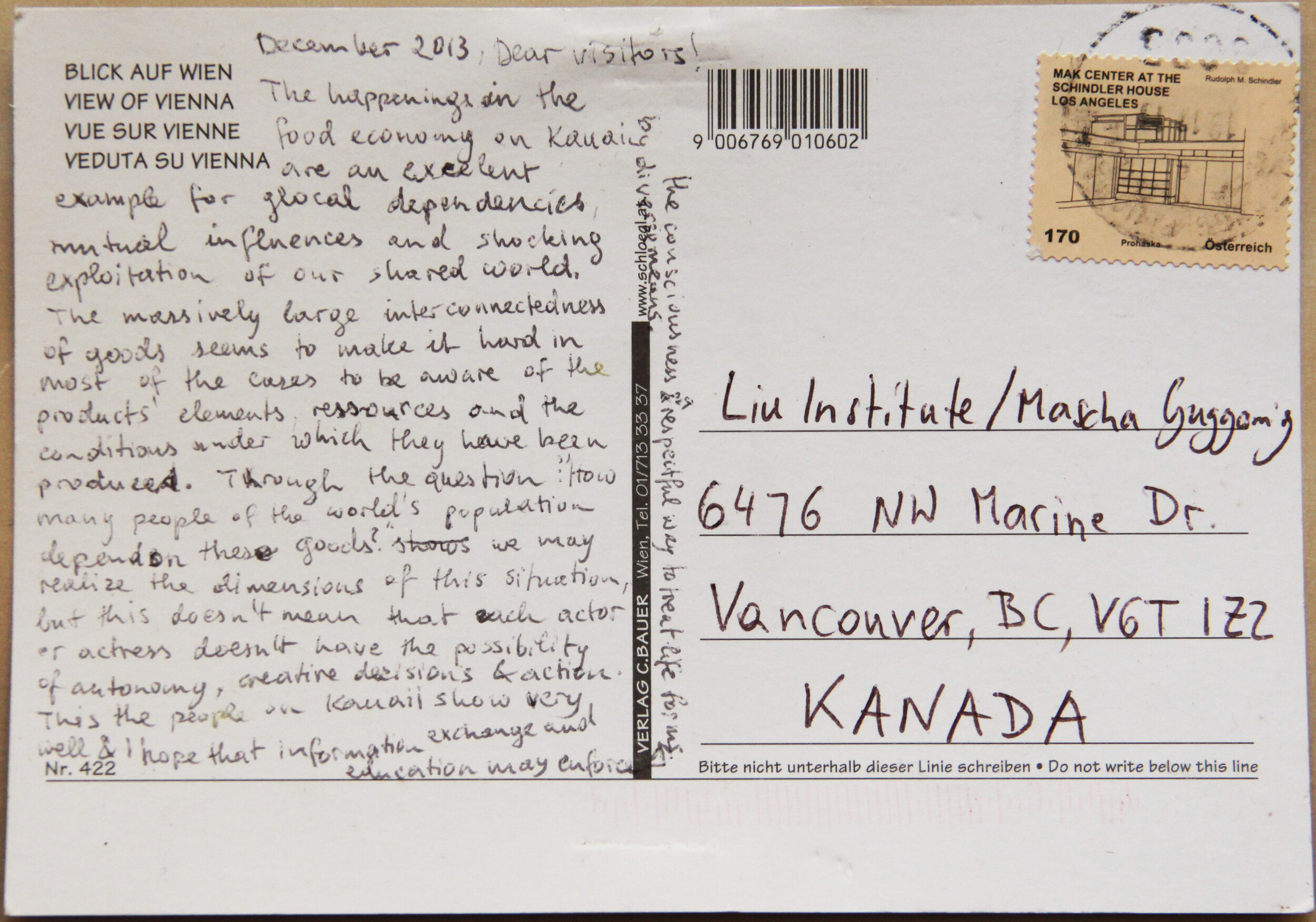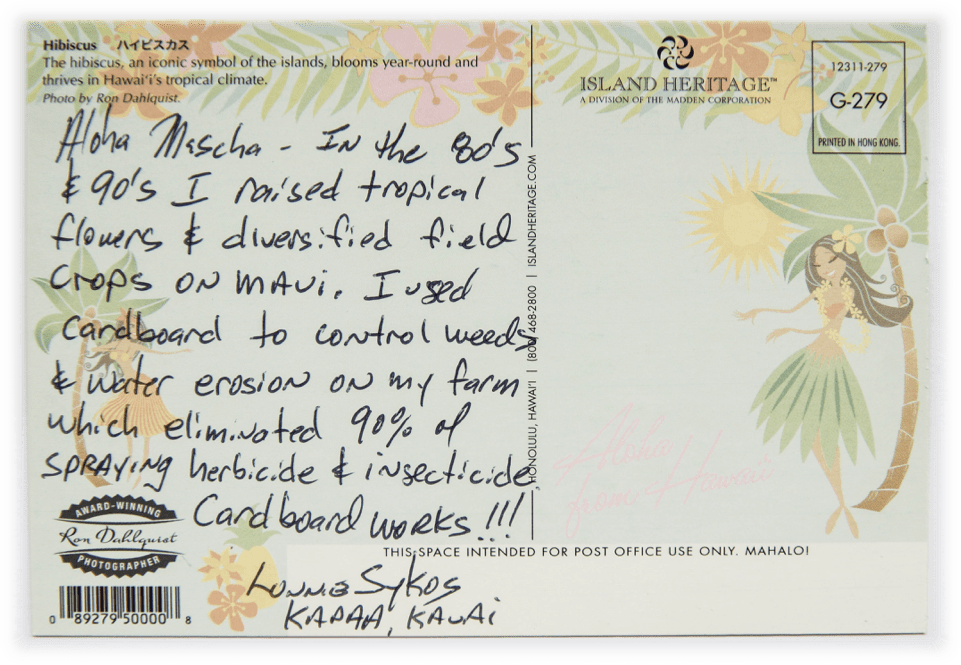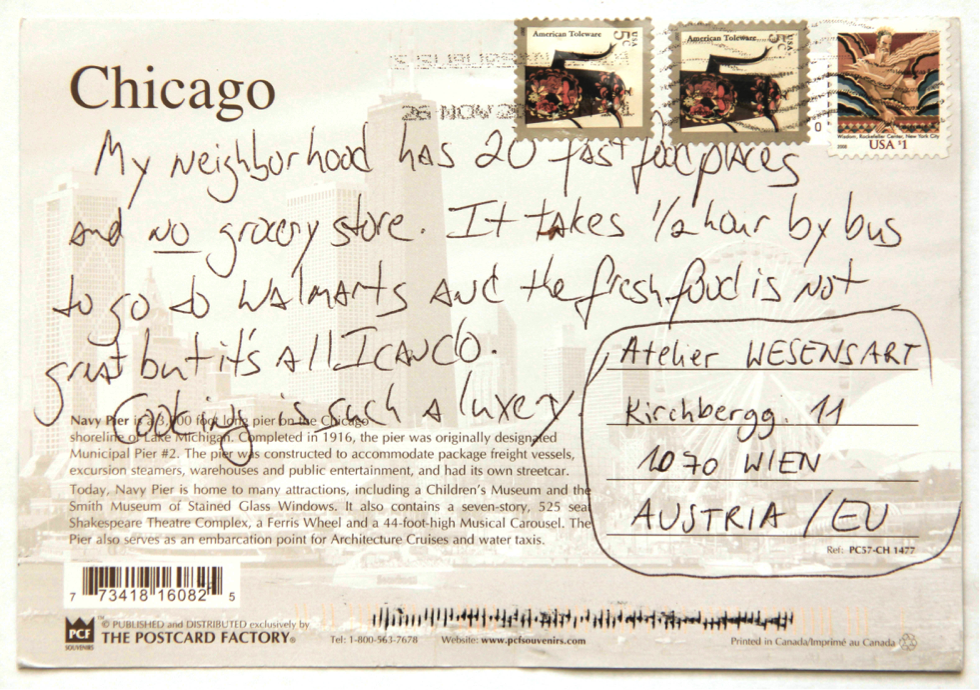Traveling Postcards: A Research Exhibition
By Mascha Gugganig (Technical University Munich)
Figure 1. Traveling exhibition "Hawaiʻi beyond the Postcard" at Wesensart Atelier, Vienna, December 2013.
In the summer of 2013, I completed the bulk of ethnographic fieldwork on education on land, ʻĀina (that which feeds), on Kauaʻi at a Hawaiian-focused charter school I collaborated with, a food sovereignty movement of white settler environmentalists and Känaka Maoli (Native Hawaiian) activists (see Gupta 2015), and the agricultural biotechnology industry. I studied epistemic differences among Känaka Maoli youth and these different communities and how and why certain forms of knowledge are given more credibility than others (Gugganig 2016). Given my primary location at Kanuikapono Public Charter School on the east side (in Anahola), I also engaged with the movement that was more prominent on this side of the island (the seed biotech industry operated primarily on the west side). From there, I followed issues and events that had unfolded during my stay in 2012-2013, thus engaging actors and communities from diverse backgrounds and geographic areas. Specifically, these events related to a wide public rejection and eventual defeat of the Public Land Development Corporation (PLDC), as well as month-long debates around County Bill 2491, which sought stricter regulation of the agricultural biotechnology industry on the island. This emergent multisitedness had the effect of gathering many perspectives, among others through interviews I had conducted with teachers, farmers, students, scientists, and parents, to name a few.
In the process of transcribing these interviews, I started collecting quotes that stood out as most evocative and reflective of people's various standpoints on food, land use, specific references to ʻĀina, and/or agricultural biotechnology. I was not quite sure yet what to do with these snippets but collected them like shiny stones. Throughout my stay, I had also accumulated many photographs and film materials, and I was facing a dilemma many visual anthropologists know too well: the aspiration that the visual material should be more than merely illustrating a text-b(i)ased dissertation. I also knew that besides writing a jargony, long dissertation only a handful of professors would read, I wanted to share this topic in a more accessible and visually enticing way.
Figure 2. Street graffiti "NO GMO", painted over by local authorities. Poʻipū, South Side, Kauaʻi.
Figure 3. Sign "Stop GMO Farming Poisoning our Children Air, Water, Land." Kīlauea, North Shore, Kauaʻi.
One of my visual data sets included photographs that documented the presence of signs, graffiti, and posters denouncing "GMOs" (genetically modified organisms) and pesticides. They reflected a growing public opposition primarily on the east side to the agricultural biotech industry on the west side (see Figures 2 and 3).
Figure 4. One of twelve postcards printed for the exhibition "Hawaiʻi beyond the Postcard." (Image)
Figure 5. One of twelve postcards printed for the exhibition "Hawaiʻi beyond the Postcard." (Back, text)
Similar to anthropologist Miriam Kahn's (2011) study on Tahiti's layers of nuclear waste, these signs and graffiti went beyond postcard images of tourist visions of tropical paradise (see Mamyia 1992). As such a tourist place, these photographs presented an image of Kauaʻi that the local tourist board very likely did not envision. It struck me to think of these public visual testimonies as tourist sites. What messages would postcards of these realities deliver, and how could I incorporate them into my research, and/or dissemination thereof?
I started creating twelve postcards with these sites, which I would then pair with the collected anonymized quotes.[1] When I produced the postcards, I flipped around the common practice of printing the image as gloss and the blank side for text as matte. By that, I wished to do two things: conceptually overturn or invert the touristic image of Kauaʻi, and by that also play with the role of image and text. Text—the interview quotes—should become an "image" of its own: a snapshot "illustration" of my dissertation. By printing the images matte, I aimed to convey a slightly dull, less-rosy yet still-dreamy aura that plays with common colonial postcard images and imaginaries of "paradise," like Hawaiʻi. Furthermore, given that the matte side invites writing (compared to the glossy side, where ink inconveniently smudges), the now-matte image turned into something that could be "worked on," transformed.[2]
Figure 6. Exhibition at Wesensart Gallery, Vienna, December 2013. Text of postcard printed as glossy.
Figure 7. Three remaining postcards from the exhibition, images printed as matte.
Around that time, I also developed the idea of a traveling exhibition to be shown at different venues throughout the time of writing my dissertation. For this, I incorporated another set of images I had worked on that vividly captured the question of food sovereignty and sustainability in Hawaiʻi. As a volunteer for the Kauaʻi Food Forest, I documented the permaculture practice of flattening cardboard in order to repurpose it as mulch, weed suppressor, and water-retaining system. The photographs formed an evocative visual statistic of Hawaiʻi's imports (see Figures 8 through 10).
Figure 8. Cardboard from California, repurposed as weed suppressor and mulch at Kauai Food Forest.
Figure 9. Used cardboard as part of the installation "Visual Framings of Changing Orders," Harvard University.
Figure 10. Six months after the first layering with cardboard, slowly breaking down.
There was also something intriguing about the transformation of these boxes into—dirt. In the documentary In Grave Danger of Falling (Gailey 1989), permaculturalist Bill Mollison spreads newspaper on his potato patch and explains that "we turn this information into food. This is the best use for advertising, the best use for news, bad news is gonna be good news." Here, the side effects of food imports—an oversupply of cardboard on a finite island—are turned into growth facilitators for local food production.
I included twelve large-print images and one actual piece of cardboard in the exhibition for people to meditate on food and environment relations while walking through the exhibition (Gugganig 2016b). The goal was to create an engaging arts-based ethnographic exhibition similar to Lydia Degarrod's Geographies of the Imagination (2013). Inspired also by scholars in science and technology studies that problematize the neat separation of production and dissemination of facts (e.g., Wynne 2006), I did not follow the classic science-communication approach of conveying research results as final object to an audience discussing (and eventually accepting) the exhibited "facts." Rather than gathering responses to a core thesis, I conceptualized the exhibition in the form of relatable themes—food production, land use, and agricultural biotechnology. The goal was to highlight how these issues are not "isolated" to an island, as technoscientific applications in agriculture are an issue in need of discussion in many parts of the world. In retrospect, I recognize that this attempt of de-isolation—to present these issues as commonalities in other parts of the worlds—inadvertently "flattened" the specifics of the Kauaʻi location—that is, settler-colonial dynamics in food-sovereignty efforts.
Figure 11. Examples of visitors' postcards. There was a total of 70 postcards, though some may have been lost in the various postal systems.
The circumstance of showcasing the exhibition during my (dissertation) writing phase had the additional conceptual effect of collecting "porous" and open data in the form of the different quotes/perspectives and visual impressions from Kauaʻi that I had not yet analyzed (see Figures 4 and 5). Instead, I invited people to share their thoughts on these relatable themes by writing their own postcards, which I would subsequently send via mail to the next location where the exhibition was shown.[3] Over time, the postcards became part of a growing exhibition.
Figures 12-17. Examples of visitors' postcards. There was a total of 70 postcards, though some may have been lost in the various postal systems.
Visitors would often ask whom they should write to. When I explained that they could address anyone—those that would see the exhibition next (often I was able to say the location), or people on Kauaʻi where the exhibition would return to—there was often a thrill in knowing that other visitors they did not know would read their postcards. Some felt prompted to respond to something they had read on a postcard, others wrote to a real person (e.g., to the author), an imagined next generation, or to no one in particular.
In some cases, I would also ask visitors to write down something interesting they had shared in conversations with me. For instance, in response to the cardboard images, a gardener from Maui shared with me that some decades ago he had used cardboard as a very effective way to control weed growth and water erosion, which significantly cut down the use of pesticides. This was insightful to me, as I had not been aware that this practice was known and that it was explicitly used to reduce pesticide use. Another visitor made the connection to his experiences in Brazil, where legal changes similar to Kauaʻi's Bill 2491 were defeated (see two postcards above).
These insights did not generate more substantial research data. Yet the postcards added to the data collection—also in a material sense—to further research insights, and as such generated potential for new ideas, collaborations, and projects. In the form of inquiry and dialogue, they reflected the commitment to openness in anthropological research (see Pandian 2018).
Since I made use of the different countries' postal systems, openness was also reflected in an infrastructural way. Every time I went to a local post office to send off my visitors' contributions, it was a gamble whether all the postcards would arrive safely at their destination. Across the eight locations, the exhibition accumulated seventy postcards, yet several postcards got lost along the way.[4] This was frustrating and saddening in the moment, but it also symbolized the inherent contingency of ethnographic research and data collection: in the form of having no access or kuleana (Hawaiian: right and responsibility) to certain information, of losing one's digital data set, or of research participants' refusal to participate in ethnographic research (see Simpson 2014). In this way, "loss" became an inherent part of ethnographic openness.
There was also a methodological dimension in this openness that resonated with Jenny Chio's (2017) emphasis on the processual dimensions in a piece's prepublication life: "the researching, analyzing, writing, editing, re-editing, rewriting, presenting, re-presenting, writing again, editing again, resizing, and exporting phases that come before submission for publication." Indeed, as this experimental exhibition shows, these phases are not always neatly separable: the researching, thinking about, presenting, re-presenting, or writing down of one's research study points out that an anthropologist's media production and dissemination are inherently related. This is central to a multimodal approach, which "implicates the relationships between anthropologists and networked publics formed through dissemination, as well as the discussions and debates that media engender" (Collins, Durington, and Gill 2017, 142). It is particularly this latter part—the discussions people and I engendered at the various exhibition locations—that manifested materially on these postcards.
The exhibition also played with the very idea of "a final piece": Does the conscious step to leave the postcards unanalyzed—even at the moment of this publication—constitute the exhibition as final piece? Or is it now in the realm of art, where its openness generates more and other points of thinking and rethinking? Certainly, the exhibition is over now, with the website having traced its development and eventually documenting it as a cohesive piece.
In October 2016, three years after first showing the exhibition at the annual meeting of the American Anthropology Association in Chicago, the exhibition returned to the shores of Kauaʻi. Lack of time and resources made it hard to find a good venue to share the exhibition with all my research participants. Yet it made its final stop at Kanuikapono Public Charter School, where my research had started in summer 2011. As the principal shared with me, she hoped the exhibition would inspire some students for their senior project. And so did I.
I did not have many plans beyond this final stop.When I returned to Kauaʻi in February 2019, I did not expect to see the exhibition again, but my dear friends and colleagues at the school kept it in a box, ready to take with me whenever I would visit. Now, with four large prints, three original postcards, and most of people's written postcards (see Figures 7 and 18), the exhibition returned to my home, Vienna, and is again "open," both in the sense of having "lost" postcards and prints along the way and in continuing a second life. It now lives on as a methods example for students and researchers to adopt creative, collaborative, multimodal, and beyond-word ways of doing research and dissemination. In a multimodal fashion, "the trail of shared, collaborative media that our research and practice produces continues as a series of traces that adumbrate the anthropological engagement, a networked archive that twists around the final products of ethnography like snakes along the mythical caduceus" (Collins, Durington, and Gill 2017, 143). And as such, it may evolve and transform into something else altogether.
ACKNOWLEDGEMENTS
I want to thank the Liu Institute for Global Issues at the University of British Columbia for their Non-traditional Research Dissemination Fund, which allowed this exhibition to come into existence. Many thanks also to the American Anthropology Association, Ursula Kermer from Wesensart in Vienna, my former co-curator at Liu Institute's Lobby Gallery Afuwa, the Society for International Ethnobiology, Sheila Jasanoff, the STS fellows, and the Harvard University Center for Environment, the anthropology graduate students at McGill University, Kyoko Sato at Stanford University, as well as Felicia Cowden, and Ipo Torio at Kanuikapono charter school on Kauaʻi, who all supported the display of the exhibition (listed in order of display). I also thank Daniela Schadauer for continuous inspirational conversations on arts-based research methods.
REFERENCES CITED
Chio, Jenny. 2017. "Guiding Lines." Cultural Anthropology website, May 2. https://culanth.org/fieldsights/1118-guiding-lines.
Collins, Samuel G., Matthew Durington, and Harjant Gill. 2017. "Multimodality: An Invitation." American Anthropologist 119 (1): 142-46.
Degarrod, Lydia N. 2013. "Making the Unfamiliar Personal: Arts-Based Ethnographies as Public-Engaged Ethnographies." Qualitative Research 13 (4): 402-13.
Gailey, Tony. 1989. In Grave Danger of Falling Food—Bill Mollison. 53 min. Australia: Visionaries: Small Solutions to Enormously Large Problems.
Gugganig, Mascha. 2016a. "Learnscapes on Kauaʻi: Education at a Hawaiian-Focused Charter School, a Food Sovereignty Movement, and the Agricultural Biotechnology Industry." Doctoral dissertation, University of British Columbia.
Gugganig, Mascha. 2016b. "Hawai'i beyond the Postcard." https://hawaiibeyond.wordpress.com/about/.
Gupta, Clare. 2015. "Return to Freedom: Anti-GMO Aloha ‘Āina Activism on Molokai as an Expression of Place-based Food Sovereignty." Globalizations 12 (4): 529-44.
Kahn, Miriam. 2011. Tahiti beyond the Postcard: Power, Place, and Everyday Life. Seattle: University of Washington Press.
Mamyia, Christin J. 1992. "Greetings from Paradise: The Representation of Hawaiian Culture in Postcards." Journal of Communication Inquiry 16 (2): 82-101.
Pandian, Anand. 2018. "Open Access, Open Minds." Cultural Anthropology website, June 15. https://culanth.org/fieldsights/1455-open-access-open-minds.
Simpson, Audra. Mohawk Interruptus: Political Life Across the Borders of Settler States. Durham: Duke University Press.
Wynne, Brian. 2006. "Public Engagement as a Means of Restoring Public Trust in Science—Hitting the Notes, but Missing the Music?" Public Health Genomics 9 (3): 211-20.
NOTES
[1] Each interviewed person gave permission for their quote to be used for this exhibition. Later, one person refused permission, whose quote I subsequently removed.
[2] Many thanks to Anna Harris for pointing me to this dimension.
[3] I thank Dada Docot for her idea of inviting visitors to write postcards.
[4] The exhibition was shown in Chicago (USA), Vienna (Austria), Vancouver (Canada), Bumthang (Bhutan), Cambridge (USA), Montreal (Canada), Stanford/Palo Alto (USA), and Kauaʻi (Hawaiʻi). Besides some postcards that got lost in the various national postal systems, in Bumthang, seventeen postcards written by participants of the Congress of the International Society of Ethnobiology were dubiously lost onsite.















